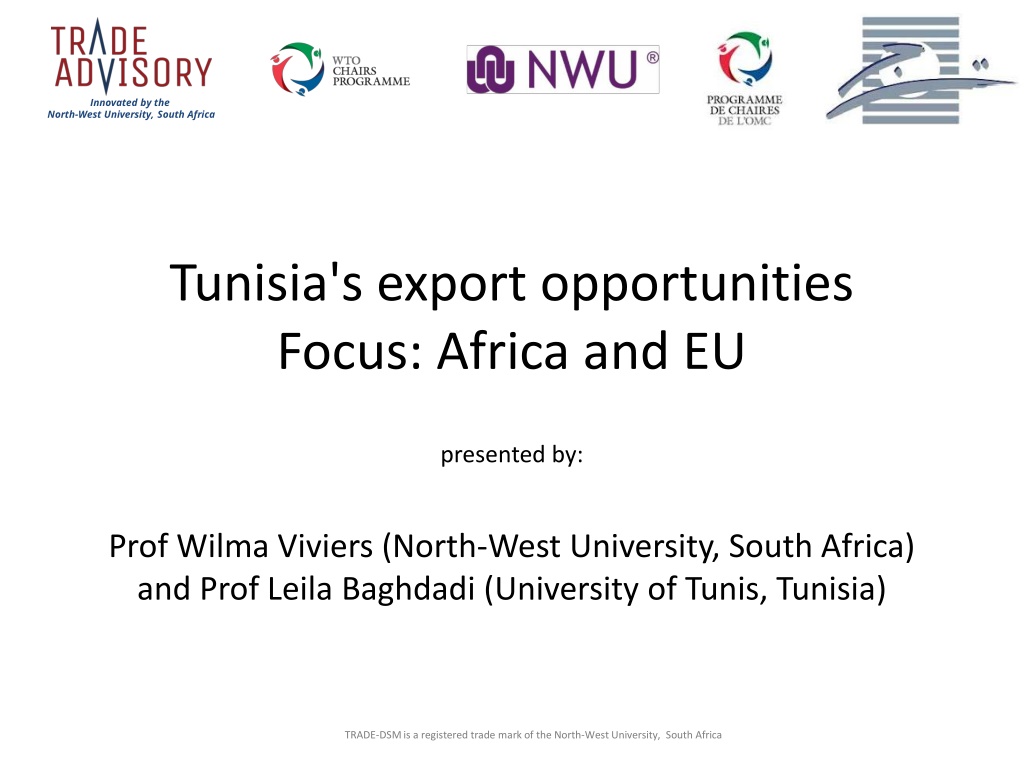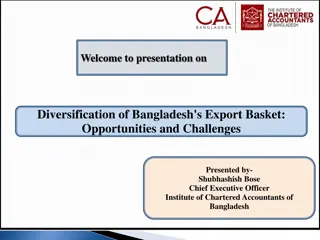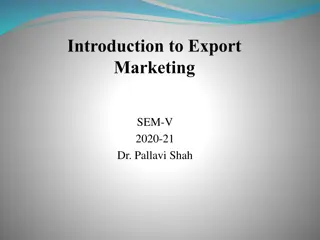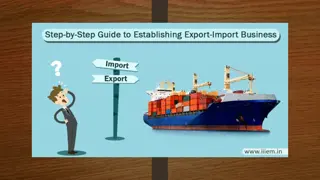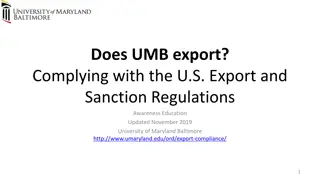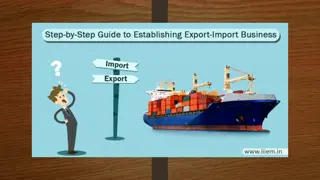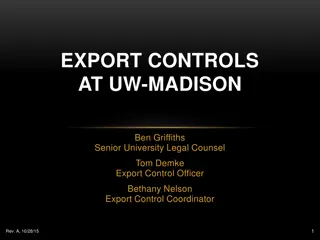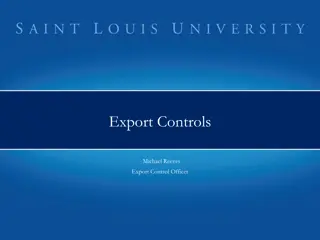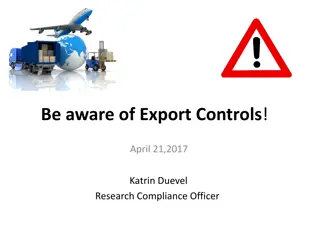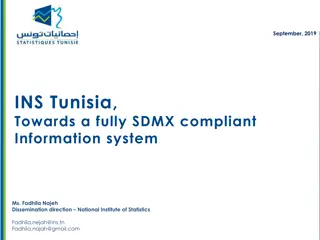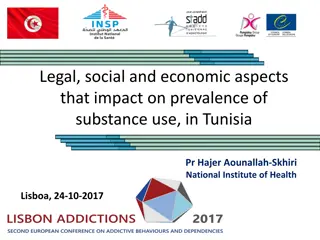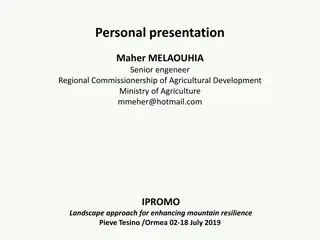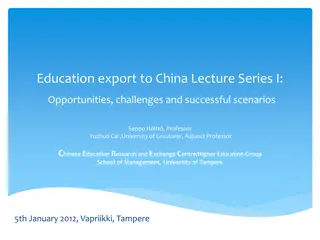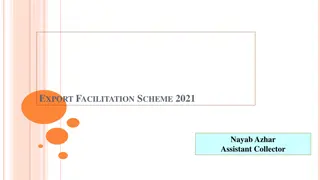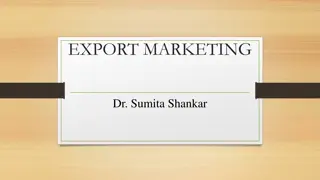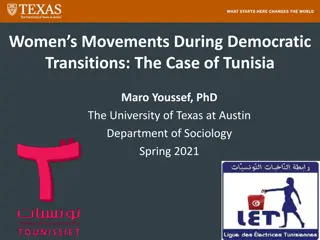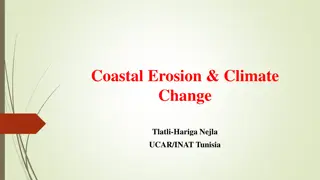Tunisia's Export Opportunities Focus: Africa and EU Presentation
Prof. Wilma Viviers and Prof. Leila Baghdadi from North-West University and University of Tunis present on Tunisia's export opportunities with a focus on Africa and the EU. The presentation outlines the TRADE-DSM methodology, identifying untapped export potential and key outcomes globally. The research project funded by Tunisian Ministry of Higher Education aims to demonstrate the Decision Support Model for bilateral trade between Tunisia and South Africa, emphasizing SME and policymaker involvement.
Download Presentation

Please find below an Image/Link to download the presentation.
The content on the website is provided AS IS for your information and personal use only. It may not be sold, licensed, or shared on other websites without obtaining consent from the author. Download presentation by click this link. If you encounter any issues during the download, it is possible that the publisher has removed the file from their server.
E N D
Presentation Transcript
Innovated by the North-West University, South Africa Tunisia's export opportunities Focus: Africa and EU presented by: Prof Wilma Viviers (North-West University, South Africa) and Prof Leila Baghdadi (University of Tunis, Tunisia) TRADE-DSM is a registered trade mark of the North-West University, South Africa
Content 1. Context 2. TRADE-DSM - overview 3. Outcomes globally, Africa and EU 4. Next steps 2
1. Context Bilateral research project funded by: Tunisian Ministry of Higher Education and Scientific Research and SA National Research Foundation (2019 - 2021) to: demonstrate the TRADE-DSM (Decision Support Model) methodology to identify bilateral export opportunities between Tunisia and SA extend desktop research to SME level and policymakers - in both SA and Tunisia This presentation: FOCUS only on TUNISIA 3
2. Methodology: TRADE-DSM Identifies export opportunities product-country opportunities with highest untapped export potential.. from Tunisia s perspective Scientific and structured approach using sequential filtering process (4 filters) and approx. 6 million pieces of information to determine products and destination countries to focus export activities Typical areas of application - Government departments (trade and industry, agriculture etc.) - Trade and investment promotion agencies and - Private sector companies (specifically for export strategy development). Range of countries for which models currently exist - China, Australia, New Zealand, Netherlands, Belgium, Thailand, Czech Republic, Greece, Mexico, USA (State of Louisiana) in Africa: South Africa, Botswana, Rwanda, Cameroon and now for Tunisia 4
3. High level outcomes Globally US$ 219 billion potential 646 products that Tunisia already exports 160 markets ~ 27 212 combinations (that meet DSM requirements) No Value1 (US$ Mn) 828 2,694 2,171 3,778 2,911 3,313 2,046 900 3,169 637 1,135 709 597 Major geographic regions Northern America Western Europe Eastern Asia Southern Europe Northern Europe Eastern Europe South-Eastern Asia Central America Western Asia Oceania South America Northern Africa Southern Africa 53,566.67 52,483.23 30,895.93 18,465.15 16,585.99 16,236.75 13,553.14 6,187.85 4,904.69 2,313.81 2,011.77 1,198.70 459.69 1) Ranked descending by value of untapped potential 5
3. High TRADE-DSM level outcomes focus on Africa region-level 53% of valueof untapped potential associated with Northern Africa 36% of number of opportunities associated with Western Africa Eastern Africa 17% 5% Middle Africa 4% 3% Western Africa 36% 19% Southern Africa 20% 20% Northern Africa 24% 53% 60% 40% 20% 0% 20% 40% 60% Share (% REO number) Share (% untapped potential) 7
3. High level TRADE-DSM outcomes focus on African markets 36 markets (of 54) meet all TRADE-DSM key filters, for which Tunisia has existing export capability for 590 different products resulting in 2999 possible combinations (that meet DSM requirements) with combined untapped potential valued at USD 2.2 billion (or 1% of global potential) No Value1 (US$ Mn) 709 597 1,072 503 118 Major geographic regions Northern Africa Southern Africa Western Africa Eastern Africa Middle Africa 1,198.70 459.69 431.89 120.08 65.19 1) Ranked descending by value of untapped potential 8
3. High level TRADE-DSM outcomes focus on African markets Untapped potential1 (Million USD) For 2999 possible combinations (that meet DSM requirements), Opportunities summarised across 27 industry sectors (as opposed to products) For the combined untapped potential valued at USD 2.2 billion (or 1% of global potential) 0 100 200 300 400 500 Electrical machinery (361-366) Food (301-304) Motor vehicles, parts & accessories (381- Machinery & equipment (356-359) Wearing apparel (313-315) Other transport equipment (384-387) Non-metallic minerals (342) Television, radio & communication Metal products excluding machinery (353- Professional & scientific equipment (374- Plastic products (338) Basic chemicals (334) Agriculture, forestry & fishing (11-13) Paper & paper products (323) Other chemicals & man-made fibres (335- Textiles (311-312) Other industries (392) Other mining (22, 24, 25, 29, 39) Glass & glass products (341) Note Aspects such as onshore/offshore/value chains impacting on possible opportunity utilisation decisions for these sectors will be considered in further research iterations Furniture (391) Leather & leather products (316) Tobacco (306) Basic iron & steel (351) Footwear (317) Basic non-ferrous metals (352) Rubber products (337) Wood & wood products (321-322) 9 1) Ranked descending by value of untapped potential
3. High level TRADE-DSM outcomes focus on Africa top 15 markets TOP 15 markets that meet all TRADE-DSM key filters, for which Tunisia has existing export capability for 571 different products with combined untapped potential valued at USD 2.09 billion Rank 1 2 3 4 5 6 7 8 9 10 11 12 13 14 15 Country Morocco Egypt South Africa Algeria Nigeria Libye Botswana Sudan Ghana Ivory Coast Angola Namibia Senegal Mauritius Kenya Tunisia - trade with Africa countries Existing trade versus potential opportunities Number 350 Bubble = Existing exports 300 250 Egypt Morocco Opportunities Ivory Coast Mauritius 200 Senegal 150 Ghana South Africa Namibia Libyan Arab Jamahiriya Angola 100 Nigeria Guinea Algeria Kenya Benin Burkina Faso Mali Niger Mauritania 50 0 Madagascar 0 Gabon 100 200 300 400 500 600 Million USD 'Untapped' potential value 10 Note: Sudan and Botswana have zero existing imports from Tunisia
Unveiling opportunities for a successful industrial policy focus on Africa A different methodology is used to identify new products based on a mix of various methodologies (product space methodology, import demand, centrality indices and various other parameters) for the top 15 markets identified by TRADE-DSM 11
3. High level outcomes focus on EU markets 27 markets1meet all TRADE-DSM key filters, for which Tunisia has existing export capability for 641 different products resulting in 9277 possible combinations (that meet DSM requirements) with combined untapped potential valued at USD 85.8 billion (or 39% of global potential) 1) Excluding United Kingdom Value2 (US$ Mn) 21,712.62 13,142.34 EU member countries (top10) Germany France Netherlands Spain Italy Poland Belgium-Luxembourg Czech Republic Austria Hungary No 577 563 504 492 482 479 366 350 359 356 8,612.83 7,679.74 7,388.53 4,628.64 4,301.14 2,984.81 2,510.53 1,739.07 2) Ranked descending by value of untapped potential 13
3. High level outcomes focus on EU markets Untapped potential1 (Billion USD) For 9277 possible combinations* (that meet DSM requirements), Opportunities summarised across 27 industry sectors (as opposed to products) For the combined untapped potential valued at USD 85.8 billion (or 39% of global potential) 0 5 10 15 20 Wearing apparel (313-315) Electrical machinery (361-366) Motor vehicles, parts & accessories (381- Television, radio & communication Professional & scientific equipment (374- Other transport equipment (384-387) Metal products excluding machinery (353- Footwear (317) Machinery & equipment (356-359) Agriculture, forestry & fishing (11-13) Plastic products (338) Food (301-304) Leather & leather products (316) Basic non-ferrous metals (352) Furniture (391) Other industries (392) Textiles (311-312) Basic chemicals (334) Other chemicals & man-made fibres (335- Glass & glass products (341) Non-metallic minerals (342) Paper & paper products (323) Basic iron & steel (351) Other mining (22, 24, 25, 29, 39) Wood & wood products (321-322) Rubber products (337) Note Aspects such as onshore/offshore/value chains impacting on possible opportunity utilisation decisions for these sectors will be considered in further research iterations * Excluding United Kingdom Tobacco (306) 14 1) Ranked descending by value of untapped potential
How Tunisian SMEs can benefit ? Participate . 15
Next steps Aim to reach out to: SME exporters access to information about export markets Policymakers - focused export promotion strategies 16
Please contact us if you want to participate: THANK YOU! leilabaghdadi@gmail.com Wilma.Viviers@nwu.ac.za Leila Baghdadi Wilma Viviers 17
